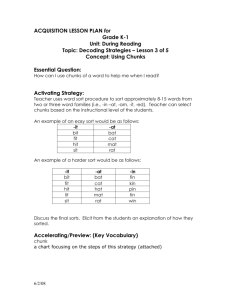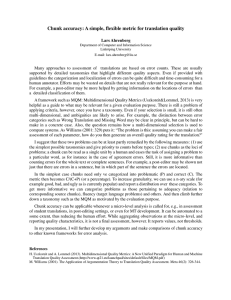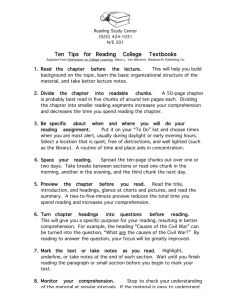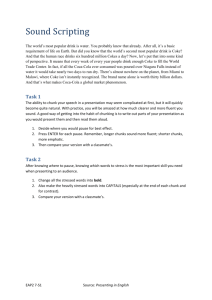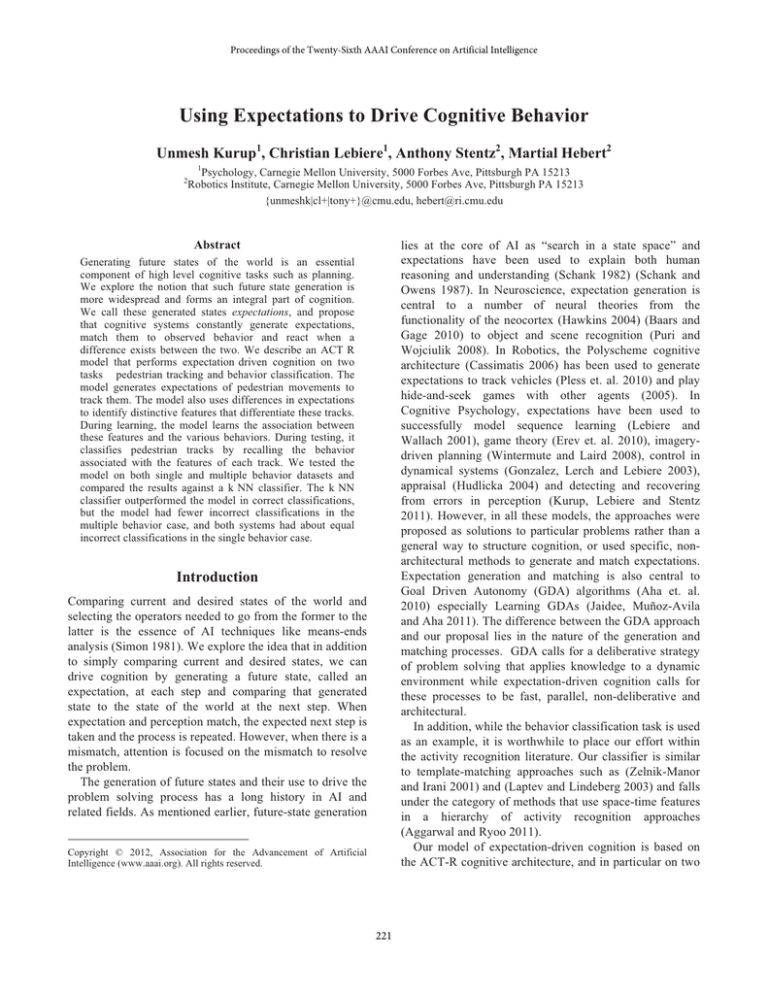
Proceedings of the Twenty-Sixth AAAI Conference on Artificial Intelligence
Using Expectations to Drive Cognitive Behavior
Unmesh Kurup1, Christian Lebiere1, Anthony Stentz2, Martial Hebert2
1
Psychology, Carnegie Mellon University, 5000 Forbes Ave, Pittsburgh PA 15213
Robotics Institute, Carnegie Mellon University, 5000 Forbes Ave, Pittsburgh PA 15213
{unmeshk|cl+|tony+}@cmu.edu, hebert@ri.cmu.edu
2
lies at the core of AI as “search in a state space” and
expectations have been used to explain both human
reasoning and understanding (Schank 1982) (Schank and
Owens 1987). In Neuroscience, expectation generation is
central to a number of neural theories from the
functionality of the neocortex (Hawkins 2004) (Baars and
Gage 2010) to object and scene recognition (Puri and
Wojciulik 2008). In Robotics, the Polyscheme cognitive
architecture (Cassimatis 2006) has been used to generate
expectations to track vehicles (Pless et. al. 2010) and play
hide-and-seek games with other agents (2005). In
Cognitive Psychology, expectations have been used to
successfully model sequence learning (Lebiere and
Wallach 2001), game theory (Erev et. al. 2010), imagerydriven planning (Wintermute and Laird 2008), control in
dynamical systems (Gonzalez, Lerch and Lebiere 2003),
appraisal (Hudlicka 2004) and detecting and recovering
from errors in perception (Kurup, Lebiere and Stentz
2011). However, in all these models, the approaches were
proposed as solutions to particular problems rather than a
general way to structure cognition, or used specific, nonarchitectural methods to generate and match expectations.
Expectation generation and matching is also central to
Goal Driven Autonomy (GDA) algorithms (Aha et. al.
2010) especially Learning GDAs (Jaidee, Muñoz-Avila
and Aha 2011). The difference between the GDA approach
and our proposal lies in the nature of the generation and
matching processes. GDA calls for a deliberative strategy
of problem solving that applies knowledge to a dynamic
environment while expectation-driven cognition calls for
these processes to be fast, parallel, non-deliberative and
architectural.
In addition, while the behavior classification task is used
as an example, it is worthwhile to place our effort within
the activity recognition literature. Our classifier is similar
to template-matching approaches such as (Zelnik-Manor
and Irani 2001) and (Laptev and Lindeberg 2003) and falls
under the category of methods that use space-time features
in a hierarchy of activity recognition approaches
(Aggarwal and Ryoo 2011).
Our model of expectation-driven cognition is based on
the ACT-R cognitive architecture, and in particular on two
Abstract
Generating future states of the world is an essential
component of high level cognitive tasks such as planning.
We explore the notion that such future state generation is
more widespread and forms an integral part of cognition.
We call these generated states expectations, and propose
that cognitive systems constantly generate expectations,
match them to observed behavior and react when a
difference exists between the two. We describe an ACT R
model that performs expectation driven cognition on two
tasks pedestrian tracking and behavior classification. The
model generates expectations of pedestrian movements to
track them. The model also uses differences in expectations
to identify distinctive features that differentiate these tracks.
During learning, the model learns the association between
these features and the various behaviors. During testing, it
classifies pedestrian tracks by recalling the behavior
associated with the features of each track. We tested the
model on both single and multiple behavior datasets and
compared the results against a k NN classifier. The k NN
classifier outperformed the model in correct classifications,
but the model had fewer incorrect classifications in the
multiple behavior case, and both systems had about equal
incorrect classifications in the single behavior case.
Introduction
Comparing current and desired states of the world and
selecting the operators needed to go from the former to the
latter is the essence of AI techniques like means-ends
analysis (Simon 1981). We explore the idea that in addition
to simply comparing current and desired states, we can
drive cognition by generating a future state, called an
expectation, at each step and comparing that generated
state to the state of the world at the next step. When
expectation and perception match, the expected next step is
taken and the process is repeated. However, when there is a
mismatch, attention is focused on the mismatch to resolve
the problem.
The generation of future states and their use to drive the
problem solving process has a long history in AI and
related fields. As mentioned earlier, future-state generation
Copyright © 2012, Association for the Advancement of Artificial
Intelligence (www.aaai.org). All rights reserved.
221
declarative facts and production rules, and to modify
existing sub-symbolic values to reflect the statistics of the
environment. A full account of ACT-R theory can be found
in (Anderson 2007) (Anderson and Lebiere 1998).
In this paper, we restrict further discussion about ACT-R
to the declarative module since its performance is most
relevant to our current work. As mentioned earlier, the
declarative module stores factual information in the form
of chunks and makes these available to the rest of the
architecture via the retrieval buffer. There are two critical
mechanisms for retrieving information in ACT-R’s
declarative module – partial matching and blending - that
are important to generating and matching expectations.
mechanisms of its declarative memory, blending and
partial matching. These mechanisms generalize the process
of generating and matching expectations and allows the
model to construct states that it has never encountered
before. We introduce a model of pedestrian tracking and
behavior classification that uses expectations to track
pedestrians based on object location information. In the
learning phase, the model uses mismatches between
expectations to generate features and learns to associate
these features with particular behaviors. During testing, it
uses discovered features to retrieve the associated behavior
from memory. We compare the model’s performance to
that of a k-NN classifier.
Partial Matching
ACT-R
In ACT-R, productions make requests for chunks in
declarative memory by specifying certain constraints on
the slot values of chunks. These constraints can range from
the very specific where every slot and value of the desired
chunk is specified to the very general (akin to free
association) where the only specification is the type of the
chunk. Request criteria also include negatives specifying
that a slot should not have a particular value as well as
ranges (in the case of numerical values). The standard
request generally specifies the chunk type and one or more
slot values but not all. If there are multiple chunks that
exactly match the specified constraints, the chunk with the
highest activation value is retrieved. The activation value
of a chunk (1) is the sum of its base-level activation and its
contextual activation. The base-level activation of a chunk
is a measure of its frequency and recency of access. The
more recently and frequently a chunk has been retrieved,
the higher its activation and the higher the chances that it is
retrieved reflecting pervasive cognitive phenomena such as
the Power Law of Practice and the Power Law of
Forgetting. Equation (2) describes how to calculate the
base-level activation of a chunk i where tj is the time
elapsed since the jth reference to chunk i, d represents the
memory decay rate and L denotes the time since the chunk
was created.
The ACT-R cognitive architecture is a modular, neurallyplausible theory of human cognition. ACT-R describes
cognition at two levels – the symbolic and the subsymbolic. At the symbolic level, ACT-R consists of a
number of modules each interacting with a central control
system (Procedural module) via capacity-limited buffers.
Modules represent functional units with the most common
ones being the Declarative module for storing declarative
pieces of knowledge, the Goal module for storing goalrelated information, the Imaginal module which supports
storing the current problem state, and the Perceptual
(Visual and Aural) and Motor (Manual and Speech)
modules that support interaction with the environment. The
only way to control a module and access the results of its
processing is through that module’s buffer. Modules can
operate asynchronously, with the flow of information
between modules coordinated by the central procedural
module.
Declarative memory stores factual information in
structures called chunks. Chunks are typed units similar to
schemas or frames that include named slots (slot-value
pairs). Productions are condition-action rules, where the
conditions check for the existence of certain chunks in one
or more buffers. If these checks are true, the production is
said to match and can be fired (executed). Only one
production can fire at a time. In its action part, a
production can make changes to existing chunks in buffers
or make requests for new chunks. ACT-R also has an
underlying sub-symbolic (numerical/statistical) layer that
associates values (similar to neural activations) to chunks
and productions. These activation (utility in the case of
productions) values play a crucial role in deciding which
productions are selected to fire and which chunks are
retrieved from memory. Only those chunks that have an
activation value greater than a threshold (called the
retrieval threshold) are retrieved. ACT-R also has a set of
learning mechanisms that allow a model to learn new
(1)
(2)
The contextual activation of a chunk is determined by the
attentional weight given the context element j and the
strength of association Sji between an element j and a
chunk i. An element j is in context if it is part of a chunk
in a buffer (e.g., it is the value of one of the goal chunk’s
slots). The default assumption is that there is a limited
source activation capacity that is shared equally between
222
all context elements. The associative strength Sji is a
measure of how often chunk i was retrieved by a
production when source j was in context. In addition to the
base-level and contextual values, some randomness is
introduced into the retrieval process by the addition of
noise, which makes retrieval conform to the softmax or
Boltzmann distribution.
Without partial matching enabled, the retrieval
mechanism only considers those chunks that exactly match
the request criteria. However, in real world situations one
is seldom exposed to the exact same information, and the
mechanism therefore needs to generalize to similar
situations. When partial matching is enabled, the retrieval
mechanism can select the chunk that matches the retrieval
constraints to the greatest degree. It does this by computing
a match score for each chunk that scales down the chunk’s
activation by its degree of mismatch to the specified
constraints. Equation (3) specifies how to compute the
match score.
(3)
MP is the mismatch penalty, Sim(v,v’) is the similarity
between the desired value v and the actual value v’ held in
the retrieved chunk. With the use of partial matching, the
retrieval mechanism can retrieve chunks that are closest to
the specified constraints even if there is no chunk that
matches the constraints exactly. This is particularly useful
as shown below in situations where values are continuous
and dynamic. Since the degree of match is combined with
the activation to yield the match score, chunks that have
higher activation will also tolerate a greater degree of
mismatch. This reflects the interpretation of activation as a
measure of likelihood of usefulness (Anderson 1990).
Blending
The second aspect of retrieval is blending (Lebiere 1999), a
form of generalization where, instead of retrieving an
existing chunk that best matches the request, blending
produces a new chunk by combining the relevant chunks.
The values of the slots of this blended chunk are the
average values for the slots of the relevant chunks
weighted by their respective activations, where the average
is defined in terms of the similarities between values. For
discrete chunk values without similarities, this results in a
kind of voting process where chunks proposing the same
value pool their strengths. For continuous values such as
numbers, a straightforward averaging process is used. For
discrete chunk values between which similarities (as used
in partial matching) have been defined, a compromise
value that minimizes the weighted sum of squared
Figure 1. Examples of behaviors (a) normal (Straight &
Left), (b) Peek, (c) Detour, (d) Veer and (e) Walkback.
dissimilarities is returned. Formally, the value V obtained
by a blended retrieval is determined as follows:
(4)
where Pi is the probability of retrieving chunk i and Vi is
the value held by that chunk. Blending has been shown to
be a convincing explanation for various types of implicit
learning (Wallach and Lebiere 2003). Blending of location
information in chunks allows the model to predict future
locations of objects by giving more weight to recent
223
Figure 2: The features learned by the model overlaid on the pedestrian tracks. Each feature is denoted by a rectangular box. The circles
denote the point of divergence of tracks that led to the construction of features.
not present, proceeds to turn left at the intersection. In the
detour behavior (Fig 1(c)), the pedestrian steps out on to
the street to look for a checkpoint (as in the peek behavior)
and finding it present proceeds to walk straight rather than
turn left. In the veer behavior (Fig 1(d)), the pedestrian
turns left at the intersection, sees the checkpoint, veers off
and proceeds to walk straight on instead of continuing
along to the left. Finally, in the walkback behavior (Fig
1(e)), the pedestrian turns left at the intersection, spots the
checkpoint, reverses course and proceeds to walk back to
the starting location. The goal of the model is to track
pedestrians across the scene and classify their behavior.
perceptual information while ignoring various individual
fluctuations arising from noise. ACT-R’s blending
mechanism can be thought of as a subset of more general
approaches like Conceptual Blending (Fauconnier and
Turner 1998) where the structure of the component
concepts and the final concept is restricted to a single type
and the compositional process for constructing the blended
concept is weighted averaging. More comprehensive
elements of Conceptual Blending such as non-trivial
compositional rules, completion, elaboration and emergent
structures are absent in ACT-R blending but could be
performed using other cognitive mechanisms after the
blending process. In addition, the partial matching and
blending mechanisms in ACT-R are meant to capture the
fundamental generalization characteristics over similaritybased semantics of modeling paradigms such as neural
networks (Rumelhart et. al. 1986) (O’Reilly and Munakata
2000), albeit at a different level of abstraction.
Together, partial matching and blending allow the model
to automatically generate expectations of future states from
previously observed states.
Tracking Pedestrians
A state-of-the-art object detection algorithm (Felzenswalb
et. al. 2010) trained to detect people is used to identify the
pedestrians in the scene. The output of the algorithm is in
the form of bounding boxes for each person in the image,
together with a confidence value. The ACT-R model
converts this bounding box into a single x,y coordinate that
is the mid-point along the base of the bounding box. The
model represents this information together with the rate of
change (delta) in a chunk in declarative memory. The
model tracks pedestrians as follows – at each timestep, the
model generates an expected location (using the partially
matched and blended location and delta values from
declarative memory chunks associated with that person)
for each person previously identified. It then assigns each
location from perception to a person by picking the person
closest to that location. If a location is left over (i.e., all
known persons have been assigned to locations), a new
person is identified at that location. ACT-R’s partial
matching and blending ensure that the expected location
generated by the model places greater emphasis on the
recent history of an object while smoothing out random
variations in projecting moving directions. This process
can be seen as a spatial version of the general modeling
pattern of projecting future system states in dynamic
environments (Lebiere, Gonzalez and Warwick 2009).
Classifying Pedestrian Behavior
We tested the idea of using partial matching and blending
for expectation-driven cognition by building a model of
behavior classification for pedestrians at an intersection
with a checkpoint (Fig 1). A pedestrian enters the scene
from the left (a convenience for expository purposes) and
walks towards the right on the sidewalk. At the
intersection, the pedestrian can either go straight or turn
left. These two behaviors – walking straight and turning
left – represents the two normal behaviors in the scenario.
An example of the tracks produced by pedestrians
exhibiting these behaviors is shown in Fig 1(a). An
additional four behaviors – peek, detour, veer and
walkback - are termed suspicious. In the peek behavior
(Fig 1(b)), the pedestrian steps out on to the street to look
for a checkpoint around the building and finding that it is
224
While there are other general-purpose tracking algorithms,
this localized greedy approach is good enough for our goal
of
studying
expectation-driven
cognition.
More
importantly, doing tracking within the architecture gives us
a way to use contextual information to influence the
process in the future, which is one of the goals of this
research program.
Results
The data consisted of four examples of each behavior for a
total of 24 behaviors. In addition, we also collected a data
set with multiple behaviors. The multiple behavior data
had two examples of each behavior (for a total of ten
behaviors) in a continuous sequence with up to 3
pedestrians in the scene at any one time.
Features
The model classifies pedestrian behaviors by abstracting
their tracks into a set of features where a feature is simply a
rectangular region in the scene. If a pedestrian’s track
intersects that region, then that track is said to have that
particular feature. The directionality of the track is
captured by the sequence of features that the model builds
for each track.
The model learns the set of features as follows – it
builds up a set of expectations for pedestrians as they move
across the scene. When an expected track diverges from
the observed track by more than a prescribed angle, the
model notes the point of divergence and selects a point
along each of these tracks (expected and observed) as
feature points. When the model is done with the learning
set, it clusters these points into features. Fig 2 shows an
example of the kinds of features found by the model. The
rectangles are the features while the circles indicate the
points of divergence (that are used to cluster the features).
Learning Model
Learning Model
(Single Behavior Set)
(Multiple Behavior Set)
Made
86.1%
Made
82.4%
Correct
68%
Correct
43.8%
Incorrect
18.1%
Incorrect
38.6%
(a)
K-NN Model
K-NN Model
(Single Behavior Set)
(Multiple Behavior Set)
Made
100%
Made
Correct
83.3%
Correct
100%
50%
Incorrect
16.7%
Incorrect
50%
(b)
Table 1. The percent of classifications made, percent correct
and percent incorrect for (a) model that learns features from
the data and (b) a k NN classifier.
Classifying Behaviors
We ran monte-carlo simulations (1000 iterations) of
classification on both single and multiple behavior sets
with ACT-R parameters for retrieval threshold, noise and
match penalty set to -8.0, 0.1 and 1.0 respectively. For both
single and multiple behavior sets, we randomly selected 3
examples of each behavior (18 examples in total) for the
learning set. For single behavior classification, we used the
remaining example of each behavior for the testing set (6
examples in total). For multiple behavior classification, the
learning set remained the same while the testing set was
the multiple behavior set. Table 1(a) shows the results of
classification on both sets. The results are good for the
single behavior case, with the model making a
classification in 86% of the cases. In the remaining 14% of
the cases, there were no chunks in declarative memory that
had an activation value that was greater than the retrieval
threshold leading to the model not producing a
classification. The model correctly classified 68% of the
total behaviors and incorrectly classified 18%. The results
of classification in the multiple behavior case are poorer,
with the model incorrectly classifying about as many
behaviors as it correctly classifies (~40%). However, this is
still above chance, which is at 16.7%.
The model works in two stages. In the first stage, the
model learns the set of features as described above. In the
second stage, for each track the model learns a chunk that
captures the association between the features and the
pedestrian’s behavior. This two-stage breakdown is due to
the limited data available since feature-behavior
associations cannot be learned before the features
themselves have been discovered. With sufficient data,
these stages can be combined into a single stage where the
initial behaviors are used to discover the features and the
later ones to learn the associations.
During testing, the model uses the feature sequence it
derives for each pedestrian track to retrieve the appropriate
behavior chunk from memory. This model can be seen as a
spatial specialization of a more abstract model that
recognizes and anticipates behavior by matching action
patterns, illustrating the versatility of the cognitive
architecture across both symbolic and metric domains
(Oltramari & Lebiere, 2011).
225
Percent
Percent
Percent
% Made
% Correct
Cluster Radius
(a)
Cluster Angle
(b)
% Incorrect
Retreival Threshold
(c)
Figure 3. Percentage of classifications made, correct and incorrect vs (a) the radius of the cluster (b) the angle at which features
are detected and (c) the retrieval threshold of the ACT R model
Our future work is concentrated on understanding how
expectations can be used to make perception better by
providing context and directing attention. Additionally, we
are interested in understanding how expectation-driven
cognition can work with deliberative approaches such as
Learning Goal Driven Autonomy (Jaidee, Muñoz-Avila
and Aha 2011). Finally, the generation of an expectation is
still influenced by the model but the theory of expectationdriven cognition, given the rapidity of the generation and
matching processes, calls for an architectural solution.
Understanding how to achieve this goal with minimal
changes to the existing architecture is part of ongoing
research.
For comparison, in Table 1(b) we show the results of a
k-NN classifier. This model correctly classifies more
behaviors in both the single and multiple behavior cases.
Both models incorrectly classify about 17% of the results
in the single behavior case, but in the multiple behavior
case, the feature-learning model makes fewer mistakes,
incorrectly classifying only 38.6% of the behaviors as
opposed to 50% for the k-NN classifier.
W e also ran a number of simulations to understand the
nature of the various parameters involved in the featurelearning model. We tested the effect of three parameters –
the cluster radius (the radius of the circles in Fig 2) that
determines which cluster a divergence point (the point of
deviation from expectation) belongs to, the cluster angle
that decides whether a deviation from expectation is large
enough to consider it a feature and the retrieval threshold
of the model that determines if the activation value of a
chunk in ACT-R’s declarative memory is high enough for
retrieval. Figure 4 shows the results of these tests. We
found that the radius of the cluster and the retrieval
threshold do not matter at least for a normal range of
values. The cluster angle on the other hand has a noticeable
effect on all three percentages. The system makes more
classifications as the angle increases but that increase
comes at the expense of the number of correct
classifications. The reason for this is straightforward – as
the angle increases, features get aggregated into fewer
groups. Once the number of features becomes too low, the
model has trouble distinguishing between the different
behaviors since they have the same set of features.
Acknowledgements
Conducted through collaborative participation in the
Robotics Consortium sponsored by the U.S Army Research
Laboratory under the Collaborative Technology Alliance
Program, Cooperative Agreement W911NF-10-2-0016.
References
Aggarwal, J. K. and Ryoo, M. S. 2011. Human activity analysis:
A review. ACM Computing Surveys (CSUR) 43(3).
Aha, D.W., Klenk, M., Muñoz Avila, H., Ram, A., and Shapiro,
D. (Eds.) 2010. Goal Directed Autonomy: Notes from the AAAI
Workshop (W4). Atlanta, GA.
Anderson, J. R. 1990. The Adaptive Character of Thought.
Hillsdale, NJ: Erlbaum.
Anderson, J. R. 2007. How Can the Human Mind Occur in the
Physical Universe? Oxford University Press. New York.
Anderson, J. R., Bothell, D., Byrne, M. D., Douglass, S., Lebiere,
C., and Qin, Y. 2004. An integrated theory of the mind.
Psychological Review 111 (4):1036 1060.
Anderson, J. R., Lebiere, C. 1998. The atomic components of
thought. Mahwah, NJ: Erlbaum.
Baars, B. and Gage, N. 2010. Cognition, Brain and
Consciousness: Introduction to Cognitive Neuroscience. Oxford,
UK: Elsevier. 81 83.
Cassimatis, N. 2006. A cognitive substrate for achieving human
level intelligence. AI Magazine 27(2):71 82.
Conclusion and Future Work
We investigated the idea of cognition as an active process,
driven by the generation and matching of expectations.
We built a model that used ACT-R’s declarative memory
and its partial matching and blending mechanisms to
generate expectations, and ACT-R’s procedural module to
direct cognition based on the match or mismatch between
these expectations and observed values.
226
Communication failure in dialogue and discourse. New York:
Elsevier Science.
Simon, H. 1981. The Sciences of the Artificial. Cambridge, Mass:
MIT Press.
Trafton, J. G., Cassimatis, N., Bugajska, M., Brock, D., Mintz, F.
E. and Schultz, A. C. 2005. Enabling effective human robot
interaction using perspective taking in robots. IEEE Transactions
on Systems, Man and Cybernetics, Part A: Systems and Humans
35(4): 460 470.
Wallach, D., and Lebiere, C. 2003. Conscious and unconscious
knowledge: Mapping to the symbolic and subsymbolic levels of a
hybrid architecture. In L. Jimenez (Ed.), Attention and Implicit
Learning. Amsterdam: John Benjamins Publishing Company.
Wintermute, S. and Laird, J. E. 2008. Bimodal Spatial Reasoning
with Continuous Motion. Proceedings of the Twenty Third AAAI
Conference on Artificial Intelligence (AAAI 08), Chicago,
Illinois.
Zelnick Manor, L. and Irani, M. 2001. Event based analysis of
video. In Proceedings of the IEEE conference on Computer
Vision and Pattern Recognition (CVPR). IEEE, Los Alamitos,
CA.
Erev, I., Ert, E., Roth, A. E., Haruvy, E., Herzog, S., Hau, R.,
Hertwig, R., Stewart, T., West, R., and Lebiere,, C. 2010. A
choice prediction competition, for choices from experience and
from description. Journal of Behavioral Decision Making 23(1):
15 47.
Fauconnier, G., & Turner, M. 1998. Conceptual Integration
Networks. Cognitive Science 22(2):133 187.
Felzenswalb, P., Girshick, R., McAllester, D., & Ramanan, D.
2010. Object detection with discriminatively trained part based
models. IEEE Transactions on Pattern Analysis and Machine
Intelligence, 32 (9).
Gonzalez, C., Lerch, J. F., and Lebiere, C. 2003. Instance based
learning in dynamic decision making. Cognitive Science 27: 591
635.
Hawkins, J. 2004. On Intelligence. New York: Henry Holt.
Hudlicka, E. 2004. Two Sides of Appraisal: Implementing
Appraisal and Its Consequences within a Cognitive Architecture.
Proceedings of the AAAI Spring Symposium: Architectures for
Modeling Emotion. AAAI Technical Report SS 04 02. Menlo
Park, CA: AAAI Press. 24 31.
Jaidee, U., Munoz Avila, H., and Aha, D.W. 2011. Integrated
learning for goal driven autonomy. In Proceedings of the Twenty
Second International Joint Conference on Artificial Intelligence.
Barcelona, Spain.
Kurup, U., Lebiere, C. & Stentz, A. 2011. Integrating Perception
and Cognition for AGI. In Proceedings of the fourth conference
on Artificial General Intelligence. Mountaiview, CA.
Laptev, I. and Lindeberg, T. 2003. Space time interest points. In
Proceedings of the IEEE Interbational Conference on Computer
Vision (ICCV). IEEE, Los Alamitos, CA.
Lebiere, C. The dynamics of cognitive arithmetic. 1999. Wallach,
D. and Simon, H. (Eds.) Kognitionswissenschaft 8 (1): 5 19.
Lebiere, C., and Wallach, D. 1986. Sequence learning in the
ACT R cognitive architecture: Empirical analysis of a hybrid
model. In R. Sun, & L. Giles (Eds.), Sequence Learning:
Paradigms, Algorithms, and Applications. Germany: Spinger
LNCS/LNAI.
Oltramari, A., and Lebiere, C. 2011. Extending Cognitive
Architectures with Semantic Resources. In Proceedings of the
Fourth Conference on Artificial General Intelligence. Mountain
View, CA.
O'Reilly, R.C., and Munakata, Y. 2000. Computational
Explorations in Cognitive Neuroscience: Understanding the Mind
by Simulating the Brain. Cambridge: MIT Press.
Pless, R., Dixon, M., Jacobs, N., Baker, P., Cassimatis, N., Brock,
D., Hartley, R. and Perzanowski, D. 2009. Persistance and
tracking: Putting vehicles and tracjectories in context. In
Proceedings of the Applied Imagery Pattern Recognition
Workshop. Washington, D. C. 1 8.
Puri A. M, Wojciulik E. 2008. Expectation both helps and hinders
object perception. Vision Research 48:589 597.
Rumelhart, D.E., McClelland, J. L. and the PDP Research Group.
1986. Parallel Distributed Processing: Explorations in the
Microstructure of Cognition. Cambridge, MA: MIT Press.
Schank, R. C. 1982. Dynamic memory: A theory of reminding and
learning in computers and people. Cambridge, MA: Cambridge
University Press.
Schank, R. C. and Owens, C. C. 1987. Understanding by
explaining expectation failures. In R. G. Reilly (Ed.),
227


